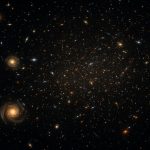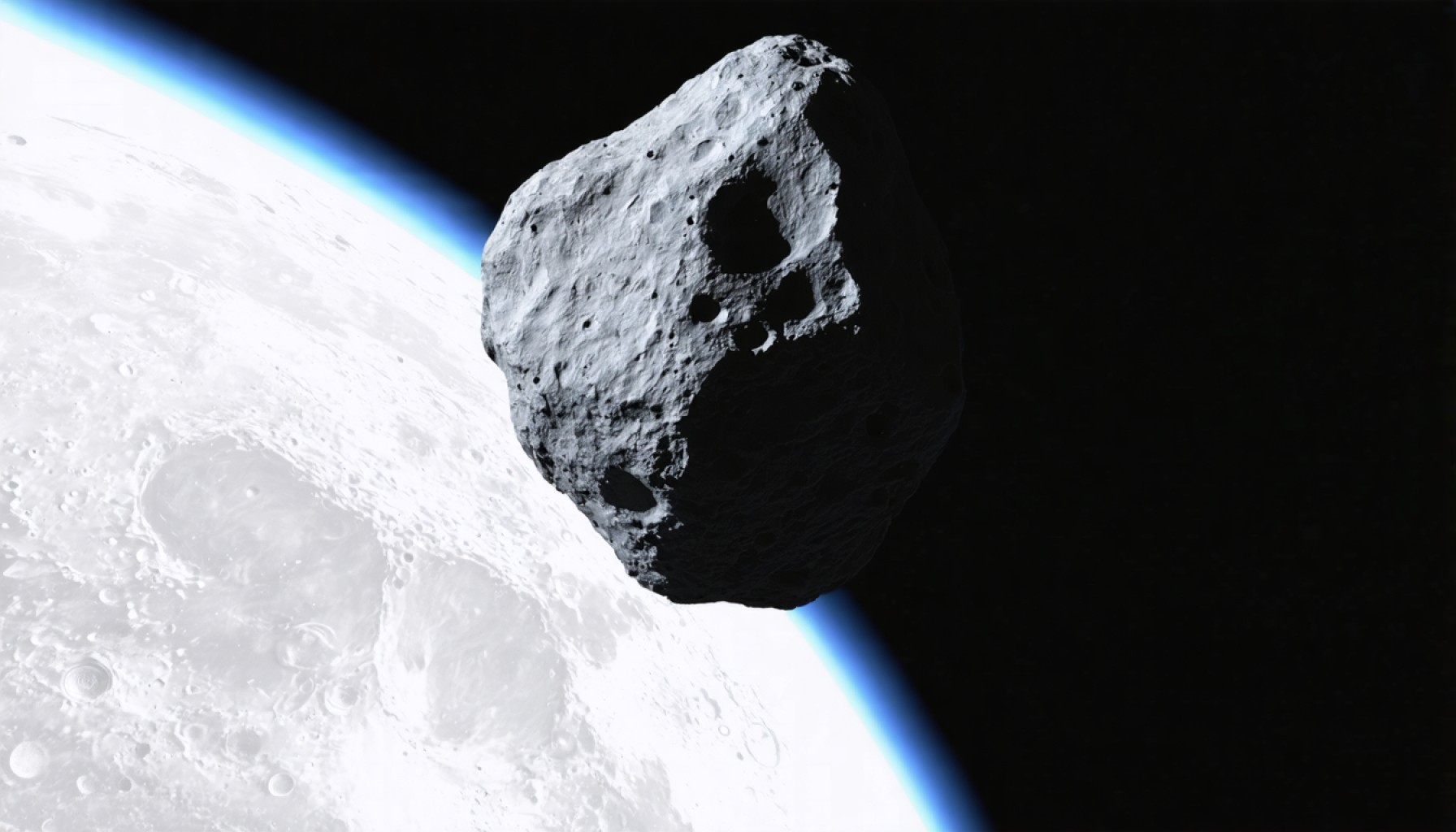- Astronomers are captivated by asteroid 2024 YR4, noted for its unusual flat, disk-like shape, akin to a spinning hockey puck.
- First observed in December 2024 via the Gemini South telescope, 2024 YR4 is a fast-rotating S-type asteroid rich in silicate minerals similar to quartz.
- Initially, the asteroid posed a significant risk of impacting Earth, with a 3.1% chance of collision, but further study has nullified this possibility.
- 2024 YR4 has an estimated diameter of 98 to 213 feet and holds a 3.8% chance of colliding with the moon in 2032.
- While a moon collision wouldn’t cause major damage, it offers a unique scientific opportunity to study crater formation.
- The asteroid’s journey underscores the enduring pursuit of cosmic knowledge and the stories awaiting discovery in the universe.
A celestial oddity is gliding through the vast expanse of space, sparking intrigue and curiosity among astronomers. Named 2024 YR4, this asteroid has been captivating scientists not just due to its trajectory, but its remarkable shape. Imagine a gigantic spinning hockey puck traversing the cosmos, likely destined to share an encounter with the moon in the year 2032.
What sets 2024 YR4 apart is its unusually flat, disk-like structure, a stark contrast to the common potato-shaped asteroids we’ve come to expect. This discovery was made by a team of astronomers peering through the powerful lenses of the Gemini South telescope, nestled high in the Chilean Andes. By analyzing the asteroid’s light patterns, the team concluded that 2024 YR4 is a fast-rotating S-type asteroid, teeming with silicate minerals akin to terrestrial quartz.
Discovered in December 2024, the asteroid initially caused a stir when data indicated a significant risk of impacting Earth. At its peak, scientists feared a 3.1% chance of an Earth collision—a record-high probability for an object of its size or larger, tagging it an ominous “city killer.” However, as research mounted, the danger to Earth receded to virtually null, placing the spotlight firmly on the moon.
With a current diameter estimate ranging between 98 to 213 feet, 2024 YR4 harbors a 3.8% chance of impacting our lunar neighbor. Though its potential strike would not inflict major damage upon the moon, such an event would present an unprecedented scientific boon. If impact unfolds, researchers anticipate a rare opportunity to study crater formation dynamics, offering insights into the kinetic artistry beyond our skies.
The saga of 2024 YR4 serves as a compelling reminder of the myriad stories hidden within our universe. With each celestial body telling a unique narrative, our quest to understand these tales continues to drive our pursuit of cosmic knowledge. The unfolding journey of 2024 YR4 encapsulates the intrigue that fuels our exploration, keeping us ever-curious about the mysteries that lie beyond our world.
Amazing Discovery: Giant Asteroid 2024 YR4 on a Lunar Collision Path!
Asteroid 2024 YR4 has piqued the interest of astronomers worldwide, not just for its unusual shape but also for its planned lunar encounter. This fast-rotating, disk-like asteroid made largely of silicate materials symbolizes a fascinating chapter in celestial exploration. Here’s a deeper dive into the intricacies of 2024 YR4, along with essential insights and predictions.
Exploring the Unique Features of Asteroid 2024 YR4
– Uncommon Shape: Unlike the typical potato-shaped asteroids, 2024 YR4 resembles a flattened, spinning hockey puck. This unique structure offers a new avenue of research, especially concerning how such shapes form and persist.
– S-Type Composition: Comprised primarily of silicates and similar in mineral composition to Earth’s quartz, 2024 YR4 is categorized as an S-type asteroid. This classification aids our understanding of asteroid composition and the solar system’s history.
– Size and Potential Impact: Measuring between 98 to 213 feet in diameter, the asteroid’s mass and shape present distinct trajectory dynamics. It currently shows a 3.8% probability of impacting the moon by 2032, a scenario that could offer groundbreaking insights into impact mechanics.
Revisiting Early Concerns and Potential for Scientific Study
In December 2024, initial estimates raised alarms with a 3.1% Earth impact probability. Dubbed a potential “city killer,” this far-off threat has since been nullified, although the asteroid’s lunar trajectory remains a focal point for potential unprecedented studies on crater formations if an impact occurs.
Scientific and Real-World Implications
– Crater Formation Studies: An impact on the moon would provide a rare opportunity for direct observation of crater formation. Such an event could enhance models of planetary surface dynamics, substantially influencing lunar geosciences.
– Asteroid Deflection Strategies: Understanding asteroids with non-standard shapes helps refine current and future deflection techniques, which are key to planetary defense strategies.
Insights & Predictions
– Technological Advances: As technology like the Gemini South telescope, used in 2024 YR4’s discovery, progresses, our ability to detect and analyze distant celestial objects rapidly improves.
– Astro-Mining Opportunities: Silicate-rich asteroids present lucrative opportunities for resource extraction in space mining ventures. Future missions could focus on the economic feasibility of tapping into these mineral reserves.
Additional Considerations
– Challenges and Limitations: Studying asteroids like 2024 YR4 is not without obstacles. Their fast rotation and unusual shape require advanced modeling techniques and more robust detection frameworks.
– Ensuring Sustainability: As interest in asteroid exploration grows, ensuring that space missions focus on sustainable practices to minimize space debris and ensure the safety of future explorations is crucial.
Quick Recommendations for Aspiring Astronomers
– Stay Updated on Next-Gen Telescopes: The capabilities of telescopes such as the upcoming Extremely Large Telescope (ELT) will provide enhanced observational data, key for studying similar space phenomena.
– Explore Careers in Planetary Defense: Courses in asteroid science and planetary defense are expanding, reflecting their increasing importance.
– Join Citizen Science Projects: Programs allowing civilians to participate in astronomical observations and data analysis can provide valuable experience and contribute to real scientific discoveries.
By understanding asteroids like 2024 YR4, we gain insights not only into potential future threats but also into the very nature of our cosmic surroundings. For more on contemporary astronomy and exploration updates, check out the official NASA website Nasa.
 Blue Origin’s Bold Comeback: “Never Tell Me The Odds” Booster to Challenge SpaceX With August Launch
Blue Origin’s Bold Comeback: “Never Tell Me The Odds” Booster to Challenge SpaceX With August Launch  Billion-Euro Bet: UK Supercharges Global Race for Limitless Fusion Energy with Marvel Fusion Deal
Billion-Euro Bet: UK Supercharges Global Race for Limitless Fusion Energy with Marvel Fusion Deal  Dell’s Bold Move: New India Head, Surging AI Partnerships, and a Stock Price Rocketing 24%—What’s Next for This Tech Giant?
Dell’s Bold Move: New India Head, Surging AI Partnerships, and a Stock Price Rocketing 24%—What’s Next for This Tech Giant?  Lucid Group’s Bold Boardroom Shakeup: Is a Turnaround Finally Coming for This EV Underdog?
Lucid Group’s Bold Boardroom Shakeup: Is a Turnaround Finally Coming for This EV Underdog?  JWST’s Largest Cosmic Map Ever Stuns Astronomers: See Nearly 800,000 Ancient Galaxies in Unprecedented Detail
JWST’s Largest Cosmic Map Ever Stuns Astronomers: See Nearly 800,000 Ancient Galaxies in Unprecedented Detail  Russia’s Air Power Shaken: Shocking Satellite Images Reveal Scale of Ukraine’s Latest Drone Strike
Russia’s Air Power Shaken: Shocking Satellite Images Reveal Scale of Ukraine’s Latest Drone Strike  XRP Skyrockets: Wall Street and Asia Rush to Make Ripple Token the Next Big Treasury Asset
XRP Skyrockets: Wall Street and Asia Rush to Make Ripple Token the Next Big Treasury Asset  Spatial Transcriptomics Analysis Platforms Market 2025: Rapid AI Integration Drives 18% CAGR Through 2030
Spatial Transcriptomics Analysis Platforms Market 2025: Rapid AI Integration Drives 18% CAGR Through 2030  Wastewater Sensor Engineering Market 2025: Smart Monitoring Drives 8% CAGR Growth Through 2030
Wastewater Sensor Engineering Market 2025: Smart Monitoring Drives 8% CAGR Growth Through 2030 